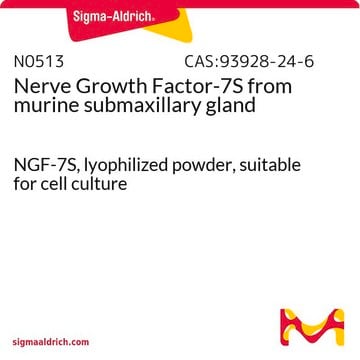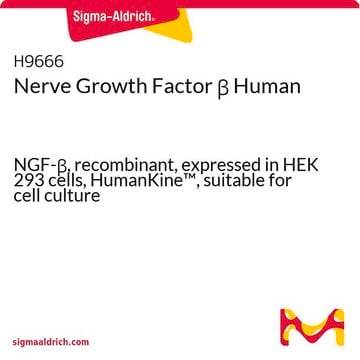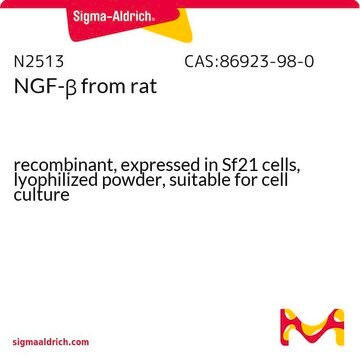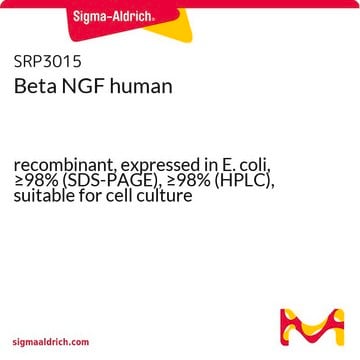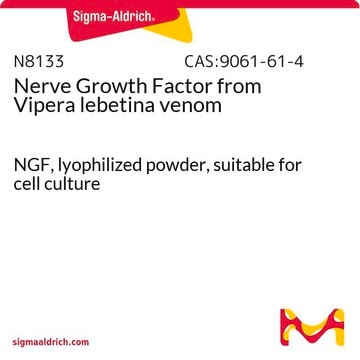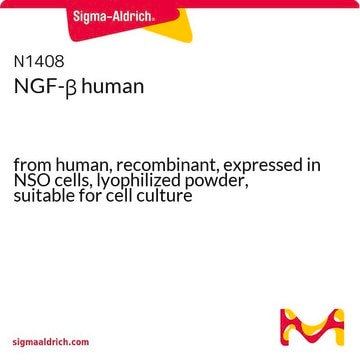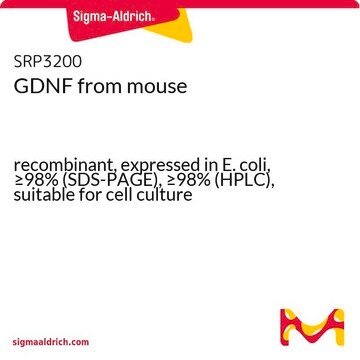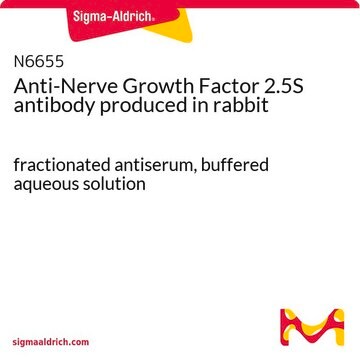N6009
Nerve Growth Factor-2.5S from murine submaxillary gland
NGF-2.5S, lyophilized powder, suitable for cell culture
Synonym(s):
NGF-2.5S
Sign Into View Organizational & Contract Pricing
All Photos(1)
About This Item
Recommended Products
biological source
mouse
Quality Level
form
lyophilized powder
potency
0.1-30 ng/mL EC50 (using PC-12 cells)
mol wt
26.5 kDa
packaging
pkg of 4X25 μg
storage condition
avoid repeated freeze/thaw cycles
technique(s)
cell culture | mammalian: suitable
UniProt accession no.
shipped in
dry ice
storage temp.
−20°C
Gene Information
mouse ... Ngf(18049)
Related Categories
General description
Nerve growth factor (NGF) is produced by different cell types: structural, accessory, and immune cells. It belongs to the neurotrophin family of trophic factors.
Application
Nerve Growth Factor-2.5S from murine submaxillary gland has been used:
- in Ham′s F-12 medium for performing growth cone collapse assay using dorsal root ganglions (DRGs)
- as a media supplement in the “process compartment” for microfluidic chamber studies
- to treat mid-luteal cells to study its effect on choline acetyltransferase (CHAT) expression
Biochem/physiol Actions
Nerve growth factor (NGF) is neurotrophic and maintains sympathetic and sensory neurons of the peripheral nervous system and forebrain cholinergic neurons. NGF promotes the development of neurite-like filaments from chick embryo dorsal root ganglia and rat PC12 pheochromocytoma cells. NGF may have a role in in vivo fetal development and nerve regeneration especially, after ischemic, surgical, or chemical injuries. NGF may also be associated with the central nervous system. It exhibits ameliorating effects against ulcers (human cutaneous, corneal ulcers, and pressure ulcers), glaucoma, maculopathy, and retinitis pigmentosa. NGF-2.5S is a type of NGF-b originally derived under dissociative conditions and often varies from NGF-b due to proteolysis arising during its purification.
Other Notes
2.5S subunit of nerve growth factor-7S (NGF-7S) is essentially the β-subunit when isolated from male mouse submaxillary glands under initially dissociative conditions by a modification of the method of Bocchini and Angeletti.
Physical form
Lyophilized from a 0.2 μm filtered solution in sodium acetate buffer.
Analysis Note
The biological activity is measured using a 3-day MTT assay.
Storage Class Code
11 - Combustible Solids
WGK
WGK 3
Flash Point(F)
Not applicable
Flash Point(C)
Not applicable
Personal Protective Equipment
dust mask type N95 (US), Eyeshields, Gloves
Certificates of Analysis (COA)
Search for Certificates of Analysis (COA) by entering the products Lot/Batch Number. Lot and Batch Numbers can be found on a product’s label following the words ‘Lot’ or ‘Batch’.
Already Own This Product?
Find documentation for the products that you have recently purchased in the Document Library.
Haeman Jang et al.
Proceedings of the National Academy of Sciences of the United States of America, 106(33), 14063-14068 (2009-08-12)
One of the greatest influenza pandemic threats at this time is posed by the highly pathogenic H5N1 avian influenza viruses. To date, 61% of the 433 known human cases of H5N1 infection have proved fatal. Animals infected by H5N1 viruses
Hongyue Dai et al.
FASEB bioAdvances, 4(1), 76-89 (2022-01-14)
Tumor innervation has recently been documented and characterized in various settings and tumor types. However, the role that nerves innervating tumors play in the pathogenesis of cancer has not been clarified. In this study, we searched for neural signaling from
Nessma Sultan et al.
Neural regeneration research, 16(9), 1821-1828 (2021-01-30)
Dental pulp stem cells (DPSCs) secrete neurotrophic factors which may play an important therapeutic role in neural development, maintenance and repair. To test this hypothesis, DPSCs-conditioned medium (DPSCs-CM) was collected from 72 hours serum-free DPSCs cultures. The impact of DPSCs-derived
Masoud Shekarabi et al.
Methods in molecular biology (Clifton, N.J.), 2311, 177-184 (2021-05-26)
Preparations of peripheral sensory neurons from rodents are essential for studying the molecular mechanism of neuronal survival and physiology. Although, isolating and culturing these neurons proves difficult, often these preparations are contaminated with nonneuronal proliferating cells. Here, we describe an
Hidetada Matsuoka et al.
The journal of histochemistry and cytochemistry : official journal of the Histochemistry Society, 68(10), 679-690 (2020-09-05)
TWIK-related acid-sensitive K+ (TASK) homomeric channels, TASK1 and TASK3, are present in PC12 cells. The channels do not heteromerize due plausibly to a lack of p11 protein. Single-channel recording reveals that most of the rat carotid body (CB) glomus cells
Our team of scientists has experience in all areas of research including Life Science, Material Science, Chemical Synthesis, Chromatography, Analytical and many others.
Contact Technical Service